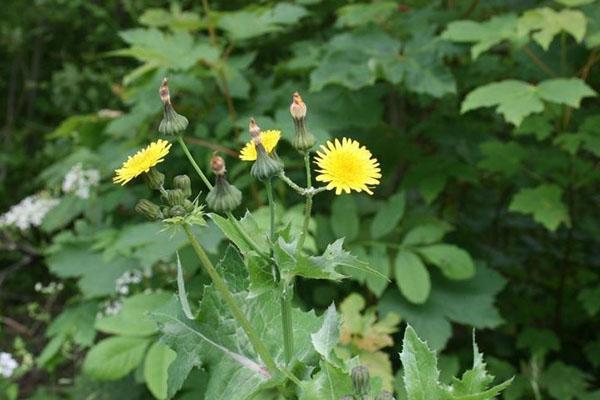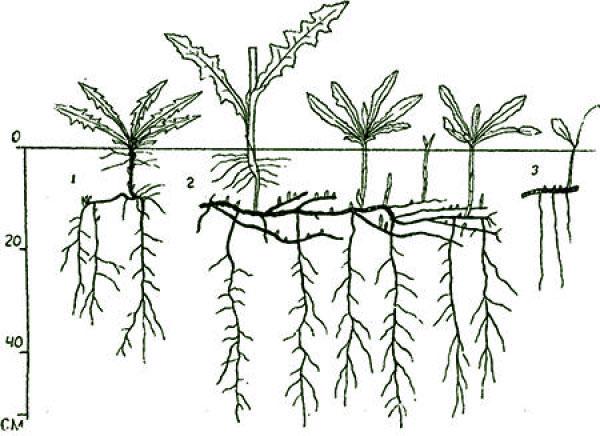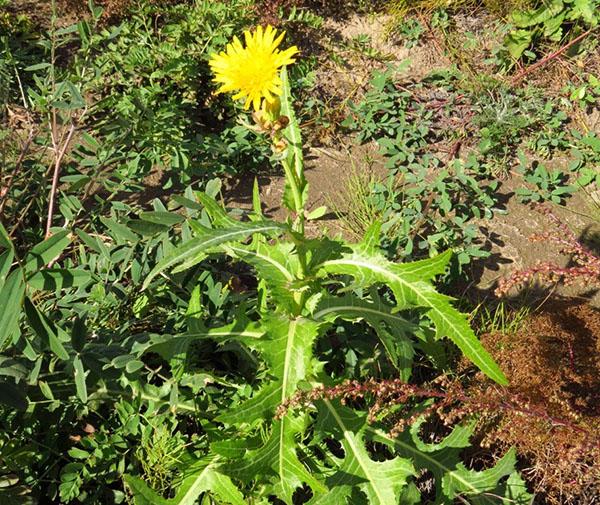Effective sow thistle control in the garden
 Sow thistle control can continue throughout the warm season. This weed is resistant to any conditions, takes root even in insufficiently fertile soils and has a powerful rhizome, thanks to which it can use a huge supply of nutrients from the soil. If the sow thistle is not removed from the plot, it can cause significant damage to the garden and affect the yield. You should figure out how to remove sow thistle without harm to cultivated plants, what drugs to use against it and what folk methods are.
Sow thistle control can continue throughout the warm season. This weed is resistant to any conditions, takes root even in insufficiently fertile soils and has a powerful rhizome, thanks to which it can use a huge supply of nutrients from the soil. If the sow thistle is not removed from the plot, it can cause significant damage to the garden and affect the yield. You should figure out how to remove sow thistle without harm to cultivated plants, what drugs to use against it and what folk methods are.
What is this plant

In order to remove the thistle from the garden, you should familiarize yourself with its varieties, and then recognize it immediately after germination:
- Field sow thistle (yellow) is a perennial weed up to 1.7 m in height. Its main root can grow up to 3-4 m, and horizontal - up to 1 m. The plant often appears in fields and near water bodies, as well as in vegetable gardens.

- Sow thistle is an annual up to 1 m high. It is smaller, so it is easier to get rid of it on the site, but it also grows quickly and takes up large areas.

- Sow thistle rough - annual up to 1 m in height. It often appears in fields, orchards and vegetable gardens, and has a dark shade of leaves.

The sow thistle root system is very dense and branched horizontally. If the weed is allowed to grow, crops will suffer from nutrient deficiencies.
Thistle control - all possible ways
 To control sow thistle, it is important to take all available measures - if you leave it on the site, cultivated plants cannot grow and bear fruit normally. The long rhizome goes deep into the soil, and it is completely impossible to pull it out. In addition, the plant greatly depletes the soil, absorbing moisture and nutrients intended for garden species. If the sow thistle root remains in the soil, it can give rise to new shoots, which will quickly grow to maximum height. The field thistle is especially dangerous - control measures will be as strict as possible, since it belongs to perennial species.
To control sow thistle, it is important to take all available measures - if you leave it on the site, cultivated plants cannot grow and bear fruit normally. The long rhizome goes deep into the soil, and it is completely impossible to pull it out. In addition, the plant greatly depletes the soil, absorbing moisture and nutrients intended for garden species. If the sow thistle root remains in the soil, it can give rise to new shoots, which will quickly grow to maximum height. The field thistle is especially dangerous - control measures will be as strict as possible, since it belongs to perennial species.
Mechanical methods
 Despite the abundance of herbicides and folk recipes for weed control, mechanical removal is indispensable. This is the easiest and most budgetary way to get sow thistle out of the garden without harm to cultivated plants. It is better to start the procedures immediately after warming, until the weed has had time to take root well.
Despite the abundance of herbicides and folk recipes for weed control, mechanical removal is indispensable. This is the easiest and most budgetary way to get sow thistle out of the garden without harm to cultivated plants. It is better to start the procedures immediately after warming, until the weed has had time to take root well.
Manual removal
 Control measures for yellow thistle and annual species can be started by manually removing the shoots. While they are young, they are easily uprooted from the ground. As plants mature, their roots become rough and go deep underground, so this method will no longer be effective.
Control measures for yellow thistle and annual species can be started by manually removing the shoots. While they are young, they are easily uprooted from the ground. As plants mature, their roots become rough and go deep underground, so this method will no longer be effective.
Digging the soil
 This method of sow thistle control is carried out during the spring preparation of the soil, before planting cultivated plants, as well as in the fall, after harvesting. During the digging of the earth with a shovel, small roots appear on the surface, which should be removed and burned.You need to try to dig as deep as possible in order to remove more roots - they can be located far underground. When digging, you can destroy not only sow thistle, but also other weeds.
This method of sow thistle control is carried out during the spring preparation of the soil, before planting cultivated plants, as well as in the fall, after harvesting. During the digging of the earth with a shovel, small roots appear on the surface, which should be removed and burned.You need to try to dig as deep as possible in order to remove more roots - they can be located far underground. When digging, you can destroy not only sow thistle, but also other weeds.
It is not recommended to loosen the soil after digging - this way you can grind the sow thistle roots and spread it over a large surface. If the procedure is carried out in the fall, the roots will freeze over the winter, and the remnants of the seedlings can be removed manually.
Use of chemicals
 Herbicides are preparations designed to control weeds. Agents based on glyphosate have proven themselves well against sow thistle: Roundup, Tornado and their analogues. Herbicides are used by spraying on vegetative parts of the plant. They affect not only sow thistles, but also garden plants. Therefore, it is better to use them in early spring, for 2-3 planting of seedlings. If there is a need to use them during the growing season, cover the plantings with foil and make sure that no drops of herbicide get on them.
Herbicides are preparations designed to control weeds. Agents based on glyphosate have proven themselves well against sow thistle: Roundup, Tornado and their analogues. Herbicides are used by spraying on vegetative parts of the plant. They affect not only sow thistles, but also garden plants. Therefore, it is better to use them in early spring, for 2-3 planting of seedlings. If there is a need to use them during the growing season, cover the plantings with foil and make sure that no drops of herbicide get on them.
When working with these fluids, certain safety precautions should be observed:
- spray the drug in dry, calm weather;
- wear a protective suit, gloves and a respirator;
- to protect the aerial parts of cultivated plants - active substances are absorbed into the leaves and penetrate into the roots after 1-2 weeks.
You can use a brush or syringe to treat sow thistle beds in summer. The drug is carefully applied to the leaves and stems weedif you cannot delete it by the root. You can also draw a small amount of herbicide into a syringe and inject it into the stem.
Biological way
 Sow thistle and control of it is a problem that can be solved in a simple way. The fact is that the plant gradually weakens and disappears from the beds in the vicinity of annual dahlias... It is enough to plant them around the site after mechanical removal of the first weed sprouts so that it does not appear again during the season. The cultivation of green manure is also effective - weeds more densely populate those beds on which nothing grows. If you plant sugar beets, mustard and other crops siderates, they will gradually reduce the growth of weeds.
Sow thistle and control of it is a problem that can be solved in a simple way. The fact is that the plant gradually weakens and disappears from the beds in the vicinity of annual dahlias... It is enough to plant them around the site after mechanical removal of the first weed sprouts so that it does not appear again during the season. The cultivation of green manure is also effective - weeds more densely populate those beds on which nothing grows. If you plant sugar beets, mustard and other crops siderates, they will gradually reduce the growth of weeds.
Traditional methods
 Traditional methods of weed control are used no less often than purchased herbicides. Spraying the green mass of sow thistle with kerosene is most often recommended. The method of cutting the stem and young growth is also used. If you break the stem during the flowering of the weed, it will also dry out over time. Its seeds will not spread throughout the entire site.
Traditional methods of weed control are used no less often than purchased herbicides. Spraying the green mass of sow thistle with kerosene is most often recommended. The method of cutting the stem and young growth is also used. If you break the stem during the flowering of the weed, it will also dry out over time. Its seeds will not spread throughout the entire site.
How to deal with sow thistle weed. This is one of the main problems for gardeners in temperate climates. There are effective drugs on the market for weed control. Their use should be combined with other methods. Manual overgrowth removal, herbicides and timely soil preparation will allow you to get rid of sow thistle without harming the crop.